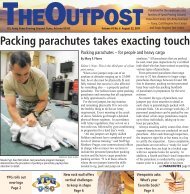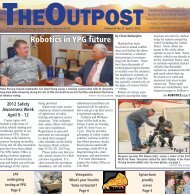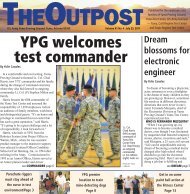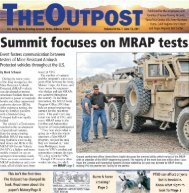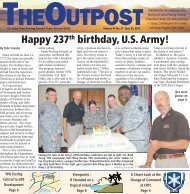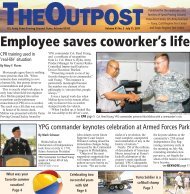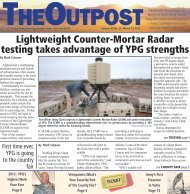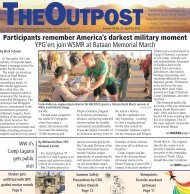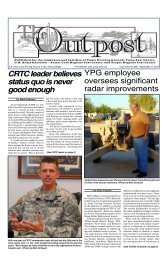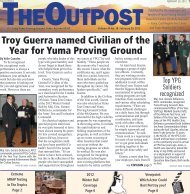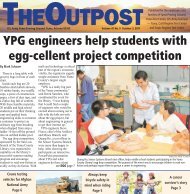Luncheon honors Hispanic Heritage Personal firearm(s) must be ...
Luncheon honors Hispanic Heritage Personal firearm(s) must be ...
Luncheon honors Hispanic Heritage Personal firearm(s) must be ...
You also want an ePaper? Increase the reach of your titles
YUMPU automatically turns print PDFs into web optimized ePapers that Google loves.
OUTPOST, Octo<strong>be</strong>r 25, 2010 — 1<br />
Fall Festival will <strong>be</strong> held on Friday, Octo<strong>be</strong>r 29<br />
from 6-8p.m. at Cox Field. There will <strong>be</strong> lots of games, prizes and costume<br />
contests. Cake donations for the cakewalk are needed. For more<br />
information, contact Paula Alarcon at 328-3119.<br />
P u b lished for the employees and families of Yuma Proving G round, Yuma T e s t C e n t e r,<br />
U . S . Army Garrison - Yuma, Cold Regions Test Center, and T ropic R e g i o n s T e s t C e n t e r<br />
U.S. Army Yuma Proving Ground, Yuma, Arizona 85365 YPG Website: www.yuma.army.mil Volume 40, No.010 – Octo<strong>be</strong>r 25, 2010<br />
<strong>Luncheon</strong> <strong>honors</strong> <strong>Hispanic</strong> <strong>Heritage</strong><br />
by Chuck Wullenjohn<br />
A num<strong>be</strong>r of activities took place at<br />
Yuma Proving Ground in past weeks<br />
to increase awareness and knowledge<br />
of the <strong>Hispanic</strong> culture, diversity and<br />
accomplishments, such as piñata parties<br />
with students at Price Elementary<br />
School and the tasting of several dozen<br />
samples of homemade salsa made<br />
by YPG employees. Tuesday, the<br />
signature event of the month-long<br />
celebration took place – a luncheon<br />
highlighted by the remarks of Yuma<br />
County Superior Court Judge Maria<br />
Elena Cruz. The attendance of nearly<br />
125 consisted mostly of mem<strong>be</strong>rs of<br />
YPG’s workforce, though U.S. Representative<br />
Raul Grijalva carved time<br />
out of his busy schedule to take part.<br />
The theme for this year’s <strong>Hispanic</strong><br />
<strong>Heritage</strong> Month is “<strong>Heritage</strong>, Diversity,<br />
Integrity and Honor: The Renewed<br />
Hope of America.” Judge Cruz<br />
incorporated the meaning of the theme<br />
into her remarks which descri<strong>be</strong>d her<br />
working-class background, the values<br />
she inherited and her decision to go<br />
into the law profession. When the<br />
family moved to Yuma from Puerto<br />
Rico and she enrolled in Kofa High<br />
School, she was unable to communicate<br />
in English.<br />
“Num<strong>be</strong>ring more than 48 million,<br />
<strong>Hispanic</strong>-Americans comprise our<br />
nation’s largest racial or ethnic minority,”<br />
she pointed out in her formal<br />
remarks. “Many come with amazing<br />
stories of strength, endurance and<br />
determination to succeed.”<br />
<strong>Hispanic</strong> <strong>Heritage</strong> Month <strong>be</strong>gan<br />
Septem<strong>be</strong>r 15 and runs through the<br />
middle of this month. The <strong>be</strong>ginning<br />
date represents the anniversary of<br />
independence for five Latin American<br />
countries: Costa Rica, El Salvador,<br />
Guatemala, Honduras, and Nicaragua.<br />
In addition, Mexico declared<br />
its independence from Spain on Septem<strong>be</strong>r<br />
16 and Chile on Septem<strong>be</strong>r<br />
18. Yuma Proving Ground has <strong>be</strong>en<br />
observing the event for 38 years.<br />
According to luncheon chairman<br />
and YPG <strong>Hispanic</strong> Manager Yolanda<br />
(See <strong>Hispanic</strong> on page 3)<br />
Dancers left to right Yvonne Kennedy, Mireya Rodriguez, Carmen Juarez and Rocio Fernandez, entertain the 100<br />
plus attendees at the YPG's <strong>Hispanic</strong> <strong>Heritage</strong> Month celebration. (Photo by Mark Schauer)<br />
<strong>Personal</strong> <strong>firearm</strong>(s) <strong>must</strong> <strong>be</strong><br />
registered, properly stored<br />
by Mary F. Flores<br />
Army Regulation 190-11, Physical<br />
Security of Arms, Ammunition, and<br />
Explosives requires Installation Commanders<br />
to establish procedures and<br />
publicize punitive policies regulating<br />
privately-owned weapons, explosives,<br />
and ammunition on the installation.<br />
In order to meet the requirements of<br />
this regulation the Commander, U.S.<br />
Army Yuma Proving Ground, issued<br />
a new regulation, USAYPG 190-11,<br />
regarding <strong>firearm</strong>s, weapons or explosives<br />
which went into effect on Octo<strong>be</strong>r<br />
15, 2010. A significant aspect of this<br />
new regulation is the requirement to<br />
register all privately owned <strong>firearm</strong>s<br />
entering the installation. Additionally,<br />
all residents of YPG <strong>must</strong> register<br />
any <strong>firearm</strong> located in their residence.<br />
Every resident and employee, including<br />
contractors, of YPG is required to read<br />
this new regulation.<br />
“Essentially this new regulation<br />
says all YPG residents and anyone who<br />
brings a personal <strong>firearm</strong> on the installation<br />
<strong>must</strong> register the <strong>firearm</strong>(s)<br />
with Police Services at building S5,”<br />
said Command Judge Advocate, Lt.<br />
Col. Michael Klausner. “If you work<br />
on the installation, you can still bring<br />
your <strong>firearm</strong> onto the installation in<br />
your vehicle as long as the <strong>firearm</strong> is<br />
unloaded when you come through the<br />
gate, and it is registered, and secured<br />
in a locked container as descri<strong>be</strong>d in<br />
USAYPG Regulation 190-11.”<br />
Residents and/or employees can<br />
register a weapon or <strong>firearm</strong> Monday<br />
through Thursday from 6:30 a.m. to<br />
3:30 p.m. at Building S5 near the YPG<br />
Travel Camp. Those wishing to register<br />
a <strong>firearm</strong> are asked not to take the<br />
weapon into Police Services; they only<br />
need to complete a registration form<br />
listing pertinent information on the<br />
weapon, such as make, model, cali<strong>be</strong>r,<br />
type, serial num<strong>be</strong>r, manufacturer,<br />
color, Once the form is filled out properly<br />
and turned into Police Services,<br />
the resident or employee will <strong>be</strong> given a<br />
registration certificate to <strong>be</strong> kept with<br />
the weapon at all times while entering<br />
the installation.<br />
As a friendly reminder, Klausner<br />
explained that nobody is authorized to<br />
carry a concealed <strong>firearm</strong> on YPG, even<br />
if a person has a concealed carry permit<br />
issued by the State of Arizona. In addition,<br />
all personally owned weapons,<br />
(See Weapon registration on page 6)
2 — OUTPOST, Octo<strong>be</strong>r 25, 2010<br />
News Notes<br />
Now is the time to talk to your<br />
children about drugs<br />
submitted by Juanita Saez, YPG Army Substance Abuse Prevention<br />
Coordinator<br />
In recognition of National Red Ribbon Week Octo<strong>be</strong>r 24-31, the YPG Army<br />
Substance Abuse Program Office is encouraging parents, guardians, caregivers,<br />
and mentors to start the conversation about the dangers of illicit drug<br />
use with their children.<br />
According to the National Institute of Health, more than half of all American<br />
kids will try drugs at least once <strong>be</strong>tween first and 12th grade with marijuana<br />
<strong>be</strong>ing the most commonly used illicit drug in the nation. Starting the conversation<br />
with your kids about the dangers of drug abuse can help steer them<br />
in the right direction. No matter how hard parents try to prevent children<br />
from experimenting with alcohol or other drugs, they may choose to do so.<br />
Here are some general tips to help you talk to your teen:<br />
•• Stay calm: The most important thing is not to act out of anger or panic.<br />
Consider your options and get whatever information you need to have a productive<br />
conversation. Don’t waste time feeling guilty or blaming yourself or others.<br />
•• Take action: Don’t blow it off as ‘no big deal.’ Talk to your teen. As a<br />
parent you’re completely justified in saying that you do not approve of your<br />
child using alcohol or other drugs. Set up a time to talk together as a family<br />
in a private setting. Think about the conversation, plan out what you want to<br />
say, and choose a time when you’re ready to face the challenge. Be sure your<br />
child is so<strong>be</strong>r: never confront a person – young or adult – when he or she is<br />
under the influence of alcohol or other drugs.<br />
•• Ask questions: Try to find out what’s going on from your teen directly<br />
and give your child the chance to explain. Express your concern. Ask openended<br />
questions about relationships with new friends, activities, school or<br />
work. Hopefully, your child will <strong>be</strong> honest with you and tell you what’s really<br />
going on so you can respond appropriately. If teens insist that they are not<br />
using, parents may consider asking them to take a drug test to prove they are<br />
clean. But remem<strong>be</strong>r, with the exception of marijuana, most drugs are only<br />
detectable for a few days after use.<br />
•• Find out when, where and why: If your teen admits to experimenting<br />
with alcohol or drugs, find out as much as you can about the circumstances of<br />
use. Was it an isolated incident? Is the use frequent? Who is your child using<br />
with? Where is he or she using? Who is providing the alcohol or drugs? Try<br />
to <strong>be</strong> understanding about mistakes your child may have made, so that he or<br />
she feels comfortable communicating with you.<br />
•• Give clear messages about your values: Set clear boundaries. Be firm<br />
about the dangers of drug use and how it can affect everyone in the family. Talk<br />
about the risks, lifetime consequences, and health problems caused by drug<br />
use. While it may <strong>be</strong> tempting, avoid glorifying your own past use of alcohol<br />
or drugs. Your teen may take this as evidence that such <strong>be</strong>havior is acceptable<br />
or harmless. However, if you are in recovery yourself, you may want to<br />
share your experience and descri<strong>be</strong> how you were able to overcome addiction.<br />
•• Monitor your child’s <strong>be</strong>havior: Watch out for changes in your teen’s<br />
<strong>be</strong>havior. If you are concerned about possible use, the first sign of a problem<br />
for many parents is change – in hygiene, friends, hobbies, grades, or family<br />
relationships. Use our signs and symptoms guide to help. If your teen has<br />
admitted to using, you may want to limit his or her allowance and access to<br />
transportation, and monitor leisure activities.<br />
•• Educate yourself: Find out what teens in your community are using.<br />
Become familiar with slang names for various drugs. And find out about support<br />
groups and treatment options in your community.<br />
•• Encourage healthy living: To help children maintain a so<strong>be</strong>r, healthy<br />
lifestyle, parents should steer them towards healthier friends and activities<br />
and encourage them to talk openly about any concerns they might have.<br />
•• Talk to a professional: If you suspect this is more than experimentation,<br />
you should arrange for your child to get an assessment from a substance<br />
(See Drugs on page 8)<br />
The OUTPOST is an unofficial publication authorized under provisions<br />
of AR 360-1. The OUTPOST is published every two weeks by<br />
the Public Affairs Office, Yuma Proving Ground. Views and opinions<br />
expressed are not necessarily those of the Department of the Army.<br />
This newspaper uses material credited to DTC, ATEC, and ARNEWS.<br />
While contributions are solicited, the PAO reserves the right to edit<br />
all submitted materials and make corrections, changes or deletions<br />
to conform with the policy of this newspaper. News may <strong>be</strong> submitted<br />
to the Editor, OUTPOST, Yuma Proving Ground, Yuma, AZ, 85365.<br />
Phone (928) 328-6533/6189 or DSN 899-6533. You can visit our web<br />
page at: www.us.army.mil or e-mail to: yolanda.canales@us.army.mil<br />
Commander .....................................................Col. Thomas Payne<br />
Public Affairs Officer........................................Chuck Wullenjohn<br />
Public Affairs Specialist/Editor........................Yolanda Canales<br />
Public Affairs Specialist....................................Mary F. Flores<br />
Public Affairs Specialist ...................................Mark Schauer<br />
Technical Editor, Cold Regions Test Center.....Clara Zachgo<br />
Congratulations to YPG's<br />
Price Elementary School<br />
Octo<strong>be</strong>r's Go-Getters!<br />
Each month, Yuma Elementary School District No. 1, selects two<br />
students who meet the criteria of working hard, performing at their<br />
very <strong>be</strong>st and are good abiding citizens. Their photos are sent to<br />
the Yuma Sun and published on the last Tuesday of every month<br />
throughout the school year. In addition to the students' photos<br />
appearing in the Yuma Sun, the YPG publication, The Outpost also<br />
publishes the students' accomplishments.<br />
Selected for the month of Octo<strong>be</strong>r are<br />
Nathan M. Heller and Katrina Policar.<br />
Nathan M. Heller Katrina Policar
<strong>Hispanic</strong> (Continued from page 1)<br />
Yuma County Superior Court Judge<br />
Maria Elena Cruz, speaks at the <strong>Hispanic</strong><br />
<strong>Heritage</strong> luncheon celebration.<br />
(Photo by Mark Schauer)<br />
Canales, the importance of the monthlong<br />
celebration is that it builds<br />
awareness of America’s <strong>Hispanic</strong><br />
culture and heritage, as well as allows<br />
the YPG workforce to sample<br />
excellent, authentic cuisine. “I’ve<br />
worked on this event for 25 years and<br />
the more I see people enjoying it, the<br />
more driven I <strong>be</strong>come,” she said.<br />
A large num<strong>be</strong>r of people from YPG<br />
contributed toward making the luncheon<br />
a success. Canales contributed<br />
a recipe for barbacoa (shredded <strong>be</strong>ef)<br />
to the proving ground’s Cactus Café,<br />
which prepared the meal, and personally<br />
oversaw food preparation to make<br />
sure everything was cooked in the<br />
authentic Mexican tradition. A group<br />
of employees – Rocio Fernandez,<br />
Yvonne Kennedy, Mireya Rodriguez,<br />
and Carmen Juarez -- got together to<br />
form a folkloric dancing troupe, four<br />
people who practiced evenings twice<br />
each week for the last three months,<br />
wearing colorful handmade gowns.<br />
Gabby Ochoa, administrative assistant,<br />
kept the luncheon flowing<br />
as mistress of ceremonies, Tom Coz,<br />
range optical measurements lead,<br />
provided live background music, and<br />
many others donated their time to put<br />
up decorations, serve meals, clean up<br />
(See <strong>Hispanic</strong> on page 8)<br />
Light jazz music was provided by Tommy and the Drifters, employees of<br />
YPG. Left to right: Barry Butz, Andrew Trujillo and Tom Coz. (Photo by<br />
Mark Schauer)<br />
Susan Arguelles (left) and Yolie Canales (right), pose for a photo with the<br />
Price Elementary School students after <strong>be</strong>ing presented with their prizes<br />
for competing in the recent <strong>Hispanic</strong> <strong>Heritage</strong> Poster Contest. Prizes for the<br />
contest were donated by the YPG Army Substance Abuse Program Prevention<br />
Office. Supplies for the posters were donated by Debbie Rickard, director<br />
for YPG's Youth Services. (Photo by Kellie Pacella)<br />
OUTPOST, Octo<strong>be</strong>r 25, 2010 — 3<br />
Teresa Saucedo (left) a mem<strong>be</strong>r of the <strong>Hispanic</strong> <strong>Heritage</strong> committee, guides<br />
one of the students to hit the pinata during the Pinata breaking event at<br />
Price Elementary School. Goodies and pinta were donated by YPG's Army<br />
Substance Abuse Program Prevention Office. (Photo by Mary Flores)<br />
Alani Miller a student at Gila Ridge High School, entertains the luncheon<br />
attendees with a num<strong>be</strong>r from professional vocalist Christina Aguilera and<br />
Santana. Alani is the daughter of Lisa Miller, administrative assistant for<br />
the YPG Judge Advocate Office (Photo by Mark Schauer)<br />
Taking first place in the Salsa Tasting Contest was Ro<strong>be</strong>rt Fillinger who said<br />
he went on the internet and used "a little bit of this and little bit of that," and<br />
came out a winner. Placing second with a "Pico de Gallo" style of salsa was<br />
Valerie Grimes. Over 125 people attend the event. (Photo by Yolie Canales)
4 — OUTPOST, Octo<strong>be</strong>r 25, 2010<br />
Dozens of mechanics work around the<br />
clock to keep test vehicles on the road<br />
by Mary F. Flores<br />
If the warfighter has driven it,<br />
it most likely has <strong>be</strong>en serviced or<br />
maintained by the people of Yuma<br />
Proving Ground’s Test Vehicle Maintenance<br />
Branch.<br />
Like a buzzing <strong>be</strong>ehive, over 50 mechanics<br />
put their skills to work each<br />
week, Monday through Saturday,<br />
working around the clock in two shifts.<br />
These mechanics perform from<br />
minor to major repairs on a huge<br />
variety of vehicles. These include<br />
M1 Abrams Main Battle Tanks, M2<br />
and M3 Bradley Fighting Vehicles,<br />
heavy equipment transport vehicles<br />
used to haul tanks, and many more.<br />
All are tested, repaired and serviced<br />
every day in several work stations.<br />
Hundreds of combat and support<br />
vehicles are driven throughout YPGs<br />
extensive test courses, spanning hundreds<br />
of miles throughout the proving<br />
ground. In extreme weather conditions<br />
similar to weather and road<br />
conditions in Iraq and Afghanistan,<br />
endurance tests are conducted on<br />
tires, oil and air filters, suspension<br />
and electrical systems and other<br />
vehicle components. As one wave of<br />
vehicles goes out for testing, another<br />
wave of test combat vehicles rolls into<br />
the maintenance and repair shop.<br />
With an array of tool boxes, sophisticated<br />
hydraulic equipment,<br />
electrical lifts capable of lifting 15,000<br />
pounds, and gigantic cranes used to<br />
move large vehicles, mechanics are<br />
well equipped to perform their jobs<br />
efficiently.<br />
“Most mechanics learned their<br />
trade skills either from previous military<br />
experience, on-the-job training,<br />
technical manuals and/or schools,”<br />
said Kenny Stuart, chief of the test<br />
vehicle maintenance team who oversees<br />
five leads and 20 mechanics. “All<br />
mechanics work under strict Army<br />
guidelines and OSHA regulations<br />
and attend yearly safety training sessions<br />
to remain up-to-date on safety<br />
practices and policies.”<br />
An additional duty performed by<br />
mechanics and vehicle test operators<br />
is to take oil samples from test vehicles<br />
every 25 hours, sending them to a<br />
An auxiliary pump is removed for maintenance on an M1A1 Abrams Main BattleTank engine by Anthony Pegram,<br />
heavy mobile equipment mechanic. (Photos by Mary Flores)<br />
laboratory to test for metal, debris<br />
and silicone. This is a requirement<br />
to ensure the good condition of engines,<br />
transmissions and other major<br />
components.<br />
“These mechanics are well trained<br />
and can perform all types of service<br />
and repairs,” said Stuart, who served<br />
over six years as an Army mechanic<br />
maintaining the Bradley Fighting<br />
Vehicle. “Most all of the mechanics<br />
in this shop have served in the armed<br />
forces and have lots of experience. The<br />
expert work they perform helps save<br />
the lives of Soldiers, and they take<br />
great pride in what they do.”<br />
Keeping up with the demands of<br />
the vehicle test mission and adhering<br />
to a stringent work schedule can <strong>be</strong><br />
a challenge for mechanics who work<br />
alongside field survey technicians<br />
recording data and test engineers<br />
who oversee various test programs.<br />
“For me one of the biggest challenges<br />
I face is trying not to get hurt<br />
or hurt anyone else, for that matter,”<br />
said Anthony Pegram, heavy mobile<br />
equipment mechanic who served four<br />
years in the Army, eight years in the<br />
Marine Corps and has <strong>be</strong>en working at<br />
YPG for six years. “Vehicles come in<br />
Rick Ramirez, heavy mobile equipment mechanic, uses a descaler to remove "carc" paint, making the area safe for<br />
welders. Carc paint is a type of paint used by the military on tanks which can produce toxic vapors when heated.<br />
Ronald Beck (right) and Paul Wilson, both heavy mobile equipment mechanics,<br />
place the doors of an M1A1 Abrams on a wooden pallett to repair crack<br />
damages that occurred during testing.<br />
and out of the shop and a lot of people<br />
are moving around constantly. I stay<br />
aware of my surroundings at all times<br />
and remain vigilant.”<br />
Every day brings something different<br />
and for Pegram the most unusual<br />
vehicle he worked on was the “white<br />
elephant,” which was an old M45 Sgt.<br />
York vehicle modified into an armored<br />
forklift. Complete with a generator,<br />
recreational vehicle air conditioner<br />
and bullet proof panels, the forklift<br />
has <strong>be</strong>en used extensively over the<br />
years to clear shells and bombs on<br />
YPG's ranges.<br />
For others, like lead mechanic<br />
Steve Kissel, who supervises 24 contractor<br />
mechanics, the most unusual<br />
piece of equipment he worked on was<br />
a pump used for fueling vehicles in<br />
the field.<br />
“I gained most of my mechanical<br />
experience from my father <strong>be</strong>cause<br />
he owns a shop that services farm<br />
equipment,” said Kissel. “The pump<br />
I worked on after <strong>be</strong>ginning employ-<br />
(See Bldg. 3490 on page 7)
Last O2s fly off into the sunset<br />
by Mark Schauer<br />
An era in military aviation history<br />
came to a close at YPG in Octo<strong>be</strong>r with<br />
the final official flight of the Cessna<br />
O-2 Skymaster.<br />
The last flight, a range inspection<br />
in plane num<strong>be</strong>r 349, conducted by<br />
Yuma Test Center Commander Lt.<br />
Col. Stephen Milton and Laguna<br />
Army Airfield pilot Ralph Arnold, occurred<br />
on Octo<strong>be</strong>r 12. Num<strong>be</strong>r 414,<br />
349’s counterpart, last flew on July 26.<br />
Both planes notched over 10,000<br />
hours of flight time during their long<br />
careers, which means each plane<br />
likely flew well over one million miles.<br />
“The O2s have <strong>be</strong>en workhorses<br />
for us, but it’s time to let them go,”<br />
said Grant Ware, director of the Air<br />
Combat Systems Test Directorate.<br />
“It’s sad, but the mission they were<br />
intended for is more adequately met<br />
with newer aircraft. The additional<br />
resources it takes to keep them running<br />
could <strong>be</strong> used in other areas.”<br />
“They’re getting hard to maintain,”<br />
added Arnold. “The O2s have gasoline<br />
reciprocating engines, whereas modern<br />
aircraft are turboprops. It takes a<br />
whole special set of tools to maintain<br />
these two airplanes.”<br />
The four passenger O2 debuted<br />
in 1967 and was used primarily as a<br />
forward air observer in the Vietnam<br />
War, which made it a favorite among<br />
Soldiers in theater.<br />
“Close air support saved lives in a<br />
lot of cases,” explained Bill Heidner,<br />
curator of YPG’s <strong>Heritage</strong> Center. “It<br />
was the O2 that spotted the enemy<br />
and marked the target area with<br />
white phosphorous for the jets coming<br />
in.”<br />
After Vietnam, the versatile aircraft<br />
served in a variety of capacities,<br />
including surveillance missions<br />
against wildlife poachers in Africa<br />
in the 1990s. When the Electronic<br />
Proving Ground at Fort Huachuca<br />
lost its aviation department in 1997,<br />
their two O2s, num<strong>be</strong>rs 349 and 414,<br />
were transferred to YPG in early 1998.<br />
“What was most unique about<br />
the O2 was the lack of torque,” said<br />
Arnold. “Whenever you applied or<br />
reduced power, the plane wouldn’t roll<br />
or yaw, it stayed perfectly straight.”<br />
Arnold attributed this to the plane’s<br />
unconventional rear propeller, which<br />
spins in the opposite direction of the<br />
traditional front propeller in the nose<br />
of the aircraft. If a pilot were unlucky<br />
enough to lose an engine, the descent<br />
would <strong>be</strong> much more restrained and<br />
controlled than in an aircraft with<br />
an engine on each wing, Arnold said.<br />
The O2s supported YPG’s test<br />
mission by serving as aerial targets<br />
for ground and air sensors under<br />
evaluation, but were used primarily<br />
to spray aerial disbursants for testing<br />
at Dugway Proving Ground in Utah.<br />
“It’s a fun airplane to fly,” said<br />
OUTPOST, Octo<strong>be</strong>r 25, 2010 — 5<br />
Yuma Test Center Lt. Col. Stephen Milton (left) shakes hands with flight operations chief Ralph Arnold prior to the<br />
last official flight of a Department of Defense Cessna O2 Skymaster. Though range inspection was the purpose of<br />
the flight, Milton appreciated the historical aspect of the flight in the venerable Vietnam-era aircraft: "It is the same<br />
as riding in a UH-1 helicopter in that you try to put yourself in the shoes of those that preceded you."<br />
Arnold. “They’re so unusual and<br />
everyone likes looking at them. I’m<br />
kind of sorry to see it go.”<br />
If everything goes according to<br />
plan, however, the O2s won’t go far.<br />
YPG’s <strong>Heritage</strong> Center is slated to<br />
get one as a permanent exhibit, and<br />
might keep both if the U.S. Air Force<br />
Museum at Ohio’s Wright-Patterson<br />
Air Force Base declines to take one.<br />
Cessna O2 Skymaster num<strong>be</strong>r 349 lifts off from YPG's Laguna Army Airfield on its last official flight. Used primarily as a forward air observer during the<br />
Vietnam War, the hardy and versatile O2 won acclaim from ground troops who depended on it for marking target areas for bombing runs. The O2 will<br />
soon <strong>be</strong> moved to its new home at YPG's <strong>Heritage</strong> Center. (Photos by Mark Schauer)
6 — OUTPOST, Octo<strong>be</strong>r 25, 2010<br />
Viewpoint<br />
Most Halloweens in the desert southwest are mild and clear. In sub-<br />
Arctic Alaska, however, frigid temperatures and heavy snow can <strong>be</strong><br />
far scarier than ghosts and goblins. For this viewpoint, we asked Cold<br />
Region Test Center personnel, "How do Alaskans celebrate Halloween?"<br />
Jeff Lipscomb, technical director:<br />
When my daughter was younger,<br />
my wife made for her an elephant<br />
costume made of heavy insulated<br />
fleece. We’ve seen it as cold as 37<br />
<strong>be</strong>low zero on Halloween night. The<br />
<strong>be</strong>st way to cope is to limit the amount<br />
of outdoor trick-or-treating and have<br />
indoor parties instead. When I was<br />
on active duty, we used to do it in a<br />
hangar and all of the units provided<br />
games and candy for the kids.<br />
Dusty Wright, network administrator:<br />
I have kids that are trick-ortreating<br />
age now, so a lot of time kids<br />
trick-or-treat as an indoor activity at<br />
organized parties at the garrison or a<br />
local church. We have taken the kids<br />
out, but it is kind of futile to wear<br />
a costume covered by a snowsuit. I<br />
remem<strong>be</strong>r it was 20 <strong>be</strong>low one year,<br />
and it just isn’t practical going doorto-door<br />
in such conditions.<br />
Monica Gaschler, data collector:<br />
We live in a rural area and<br />
don’t have little kids, so we don’t get<br />
trick-or-treaters. The weather can<br />
<strong>be</strong> pretty treacherous by Halloween,<br />
so the kids that do trick-or-treat will<br />
<strong>be</strong> wearing snow suits over their<br />
costumes—most kids around here<br />
have organized indoor events at their<br />
schools instead. It’s a bummer we<br />
don’t get trick-or-treaters, but I do<br />
bring candy to work.<br />
Marshall Brown, laborer: You<br />
have to hop in your car and drive<br />
house-to-house. If it's 49 <strong>be</strong>low zero,<br />
you have to run up to each house,<br />
then take a breather in the car on<br />
the way to the next house. I don’t<br />
wear a costume- I go as an average<br />
Joe. People around here understand.<br />
Merri Schultz, technical editor:<br />
You either have to have a specialized<br />
costume or one that is three sizes<br />
larger that can fit over a snowsuit.<br />
Sometimes you see kids running up<br />
to a door, quickly taking their coat off,<br />
then running back to their parents’<br />
car. I grew up here and remem<strong>be</strong>r<br />
trick-or-treating on a snow machine<br />
or on a big sled in 30 degree <strong>be</strong>low<br />
zero weather.<br />
Corey Kiser, assistant test officer:<br />
When I was a kid growing<br />
up here, we would tend to get our<br />
first snow around Halloween night,<br />
whereas now it comes about a month<br />
earlier. Both when I was a kid and<br />
today, kids get costumes big enough<br />
to fit over snowsuits and gloves.<br />
You’re also very picky about which<br />
neighborhoods to go to run from the<br />
car and to a house. Halloween is cold<br />
here, but the kids love it as much as<br />
everywhere else.<br />
Halloween safety<br />
tips for a safe event<br />
submitted by Safety Office<br />
Halloween, the children’s night for trick or treats…ghosts and goblins…<br />
haunts and horror… Unfortunately, some of the horrors are all too real.<br />
Every year on Halloween, many children suffer from auto accidents, fire<br />
injuries, falls, cuts, bruises or poisoned treats. Below are some awareness tips<br />
to help prevent any type of accident and/or tragedy.<br />
Risky Roadways:<br />
• Children <strong>be</strong>come careless from excitement and may run into the road.<br />
• Dusk is the time of poorest visibility – Trick or Treat during daylight.<br />
• Choose costumes that are easy to walk in and <strong>be</strong> seen by drivers.<br />
• Use reflective tape on costumes for additional visibility.<br />
Dangerous Attire:<br />
• Loose costumes, oversized bags or unsafe shoes cause falls or accidents.<br />
• Masks reduce visibility.<br />
• Sharp or pointed toy weapons are unsafe.<br />
• If wearing a mask, choose one that is cool, comfortable and easy to see<br />
out of. Take off the mask <strong>be</strong>fore crossing the street.<br />
Frightful Flames:<br />
• Billowing costumes are dangerous around open flames.<br />
• Flowing false-hair wigs are unsafe around candles.<br />
• Wigs and costumes should <strong>be</strong> of non-flammable materials.<br />
Treacherous Treats:<br />
• It’s sad, but true, some people wish to cause harm. Treats <strong>must</strong> <strong>be</strong><br />
checked for potential poisoning or unsafe objects.<br />
• All fruit should <strong>be</strong> washed and cut into small pieces to assure<br />
nothing has <strong>be</strong>en placed inside.<br />
• Unpackaged items such as popcorn or small candies should <strong>be</strong> discarded.<br />
• Candy with loose or torn wrapping should also <strong>be</strong> discarded.<br />
Weapon registration (Continued from page 1)<br />
<strong>firearm</strong>s or explosives are prohibited<br />
in any federal facilities/offices. The<br />
only exception is for residents, who<br />
can take their registered <strong>firearm</strong>s<br />
into their homes.<br />
For more information on <strong>firearm</strong><br />
registration, contact John Hopper at<br />
Police Services, (928) 328-2022.<br />
YPG Police Officer Sean Underhill explains to Phylisa Arellano, supply technician,<br />
how a personal registered <strong>firearm</strong> can <strong>be</strong> brought onto the installation.<br />
The <strong>firearm</strong> <strong>must</strong> <strong>be</strong> registered with Polices Services, unloaded and locked<br />
in the trunk or key or combination container and the registration certificate<br />
<strong>must</strong> <strong>be</strong> in the owners possession. (Photo by Mary Flores)
y Mark Schauer<br />
Editor's Note: This is the final<br />
article of a three-part series of<br />
past YPG military personnel<br />
who have <strong>be</strong>en stationed at this<br />
installation.<br />
A lifelong civilian may find it hard<br />
to understand why an ex-Soldier<br />
would want to visit one of his old<br />
duty stations after 51 years out of the<br />
service, but not a Soldier.<br />
When Jerry Goldstein left Yuma<br />
Test Station in 1959, Dwight Eisenhower<br />
was President, Barbie dolls<br />
were the newest toy sensation and<br />
Alaska was a state, but not Hawaii.<br />
After wanting to return for many<br />
Bldg. 3490 (Continued from page 5)<br />
ment here at YPG is very similar to<br />
a pump used in farming. The engine<br />
was used in tractors, so it was nice<br />
to work on something I was familiar<br />
with.”<br />
“During the second week of Septem<strong>be</strong>r,<br />
we opened 154 work orders for<br />
maintenance requests and closed 113.<br />
In addition, over 1900 man hours went<br />
Brandon Ohm, heavy mobile equipment mechanic, removes engine fan covers to repair a fuel leak on an M88<br />
Recovery Vehicle. (Photo by Mary Flores)<br />
OUTPOST, Octo<strong>be</strong>r 25, 2010 — 7<br />
Yuma Test Station Soldier returns to visit<br />
Yuma Proving Ground after 51 years<br />
Jerry Goldstien takes a photo in<br />
front of his quarters back in 1959.<br />
(Loaned photo)<br />
years, Goldstein and his wife recently<br />
took a detour from a Hawaiian vacation<br />
to see what had <strong>be</strong>come of the<br />
place he had served at so many years<br />
<strong>be</strong>fore.<br />
A native of New York City, Goldstein<br />
served in the Army Reserve<br />
while attending college. After graduating<br />
with a business degree, he<br />
decided to enlist in the regular Army<br />
rather than risk <strong>be</strong>ing drafted.<br />
“The Eisenhower years were a nice<br />
time to <strong>be</strong> in the Army,” Goldstein<br />
said. “Things were quiet. We figured<br />
there would never <strong>be</strong> another war.”<br />
Goldstein enlisted in 1957 and<br />
underwent basic training at Fort Dix,<br />
N.J. and Fort Carson, Colo. He then<br />
attended the clerk/typist school at<br />
Fort Chaffee, Ark. Upon completion<br />
of this training, Goldstein received<br />
orders to report to Yuma Test Station.<br />
“I boarded a plane on a cold, wintry<br />
day in Decem<strong>be</strong>r and got off in<br />
the middle of the desert,” Goldstein<br />
recalled with a smile. “I couldn’t <strong>be</strong>lieve<br />
it. It was the most puzzling and<br />
exciting part of my life <strong>be</strong>cause it was<br />
a whole new world to me.”<br />
At that time, Yuma Test Station<br />
was home to about one thousand<br />
Soldiers and Goldstein was assigned<br />
the role of garrison company clerk.<br />
The most difficult part of the job was<br />
compiling the morning report, a daily<br />
one or two page briefing of the day’s<br />
major events and Soldier absences<br />
that he banged out on a bulky manual<br />
typewriter. A clean and easily legible<br />
copy of the report was expected on the<br />
desk of test station commander Col.<br />
Walter Ab<strong>be</strong>y as soon as he arrived.<br />
Correction fluid had only recently<br />
towards maintenance,” said Jennifer<br />
Rivera, production control clerk who<br />
manages work orders. “Depending<br />
on the type of work and if parts are<br />
needed, it could take 30 minutes to<br />
one hour for minor repairs and more<br />
complex repairs could take up to two<br />
weeks.”<br />
For many mechanics who work in<br />
Jerry Goldstein (left) shares with Bill Heidner, YPG curator, how small the<br />
installation was back in 1959 when he arrived. "I recall wearing shorts for<br />
about eight months of the year just to keep cool," said Goldstein. (Photo<br />
by Mark Schauer)<br />
<strong>be</strong>en invented and was not yet commonly<br />
available on the commercial<br />
market; thus, if Goldstein made even<br />
a small error while facing his deadline,<br />
he had no choice but to discard<br />
whatever he had typed and start over.<br />
“I did the morning report very<br />
carefully,” Goldstein said. “It was a<br />
big deal. It had to <strong>be</strong> perfect.”<br />
Though Goldstein was aware that<br />
the test station was actively evaluating<br />
a wide variety of equipment used<br />
by the Army, including then-advanced<br />
parachutes and the primitive aerial<br />
drones that would evolve into today’s<br />
sophisticated unmanned aerial systems,<br />
his official duties never took<br />
him onto the ranges.<br />
“They kept the test areas off limits,”<br />
Goldstein said. “I never had any great<br />
desire to figure out a way to see them.”<br />
the Test Vehicle Maintenance Shop<br />
their work is not unnoticed or done<br />
in vain.<br />
“Knowing our troops are getting the<br />
<strong>be</strong>st equipment to carry out their missions<br />
gives me great job satisfaction,”<br />
said Pegram. “Coming to work every<br />
day and <strong>be</strong>ing a part of this process<br />
is a good feeling.”<br />
Though he arrived at the most<br />
temperate time of the year, Goldstein<br />
soon experienced the baking heat that<br />
makes Yuma ideal for hot weather<br />
testing. Unfortunately, he had to<br />
endure it without the <strong>be</strong>nefit of air<br />
conditioning.<br />
“I don’t recall cool air conditioning,”<br />
Goldstein said. “We had a lot of<br />
desk fans. It was tough to keep cool.<br />
We wore shorts about eight months<br />
of the year.”<br />
Goldstein was joined by his wife<br />
for part of his tenure at the test station,<br />
but there was no permanent<br />
family housing on post at that time.<br />
Instead, accompanied personnel and<br />
their families lived in trailer homes<br />
that sat on the present-day location<br />
of the housing area.<br />
“The Navy had previously condemned<br />
all of these wonderful little<br />
moveable shacks and sent them to<br />
the Army,” Goldstein said. “They<br />
were like palaces to us. There was the<br />
occasional rattlesnake, but it wasn’t<br />
a big deal.”<br />
During the period he was unaccompanied,<br />
Goldstein did all he could to<br />
avoid having to sleep in the barracks.<br />
He recalled that one of the sergeants<br />
allowed him to sleep in the post office<br />
for four or five months.<br />
“The post office was the size of a<br />
small closet, but there was room for<br />
a cot,” Goldstein said. “It was private,<br />
which was the whole idea.”<br />
Goldstein wasn’t the anti-social<br />
type, however. Though the test station<br />
had few organized activities <strong>be</strong>yond<br />
a modest recreation center that occasionally<br />
showed movies, Goldstein<br />
and his buddies engaged in a variety<br />
of sporting and recreational activities.<br />
“We played softball, ran, swam, and<br />
drank a lot of <strong>be</strong>er,” Goldstein said.<br />
“Late afternoon on the boat dock on<br />
the Colorado River drinking <strong>be</strong>er with<br />
the boys was a good way to conclude<br />
a duty day.”<br />
Goldstein regrets that he has fallen<br />
out of touch with his Yuma Test Station<br />
buddies over the past fifty years.<br />
“It’s a shame, but the memories<br />
live on,” he reminisced.<br />
Goldstein still recalls that a restaurant<br />
called the Taco Lita on Yuma’s<br />
4th Avenue was the Soldiers’ favorite<br />
local eatery. During his time at the<br />
test station, he took advantage of<br />
Yuma’s location to visit Mexico and<br />
also travelled to Los Angeles, San<br />
Diego and Phoenix for the first time.<br />
(See Goldstein on page 8)
8 — OUTPOST, Octo<strong>be</strong>r 25, 2010<br />
Family, Morale, Welfare & Recreation Happenings<br />
Drugs (Continued from page 2)<br />
abuse counselor. If help is needed, children should understand that getting<br />
counseling is not a punishment but rather an adult way to work out issues<br />
that are harmful to them and the family.<br />
Find out about local treatment programs. Please feel free to visit the Army<br />
Substance Abuse Program, Bldg. 309 or contact us at ypgsapp@us.army.mil<br />
or simply call 928-328-2249 for local substance abuse treatment programs<br />
in Yuma.<br />
The following websites are helpful tips on how to start the conversation<br />
today about drugs: http://www.timetotalk.org; http://www.drugfree.org http://<br />
family.samhsa.gov/set/drugs.aspx; and http://www.militaryonesource.com<br />
<strong>Hispanic</strong> (Continued from page 3)<br />
afterward, and much more.<br />
A student from Gila Ridge High<br />
School, Alani Miller, entertained<br />
the audience with two vocal renditions<br />
of popular latin songs. “She<br />
even learned the words to one of the<br />
songs in Spanish, which she did just<br />
for our program,” enthused Canales.<br />
An outpouring of applause from the<br />
audience greeted the end of each<br />
num<strong>be</strong>r. Alani is the daughter of YPG<br />
employee Lisa Miller.<br />
“Functions like this help us realize<br />
that people from every corner<br />
of the world have come here to live<br />
the American dream,” said Julio<br />
Dominguez, YPG technical director.<br />
“This dream does not <strong>be</strong>long to any<br />
single group of Americans, but to all<br />
of us.” He pointed out that <strong>Hispanic</strong><br />
Americans joined with fellow Americans<br />
from all cultural backgrounds,<br />
particularly in the last 100 years, to<br />
pay a steep price for the protection<br />
of freedom as mem<strong>be</strong>rs of America’s<br />
military forces.<br />
The luncheon concluded with the<br />
serving of freshly made pan dulce,<br />
Mexican sweet bread that typically<br />
is served as dessert at celebratory<br />
<strong>Hispanic</strong> meals. Canales explained<br />
that pan dulce, which actually can<br />
<strong>be</strong> one of many types of sweet bread,<br />
holds an important place in the <strong>Hispanic</strong><br />
tradition.<br />
“To <strong>Hispanic</strong> families, ending a<br />
meal with pan dulce is the same as<br />
serving a slice of apple pie in many<br />
other families,” she said. “It’s one of<br />
the traditions we want to share with<br />
everyone.”<br />
Familiar traditions like these<br />
bring people and cultures together.<br />
Education and understanding is what<br />
<strong>Hispanic</strong> <strong>Heritage</strong> month and other<br />
ethnic activities throughout the year<br />
at YPG are all about.<br />
Next Outpost deadline is noon,<br />
Octo<strong>be</strong>r 28th<br />
Sexual Assault Hotline:<br />
920-3104 or 329-3224<br />
Report Domestic Violence:<br />
328-2720 or 328-3224<br />
Goldstein (Continued from page 7)<br />
He made it as far north as Las Vegas,<br />
which at that time had a population of<br />
less than 65,000, about 25,000 fewer<br />
people than present-day Yuma. He<br />
usually hitchhiked by car, but also<br />
used a more unlikely means of travel.<br />
“I hopped aboard a C-47 aircraft<br />
once,” Goldstein said. “One weekend<br />
we flew to Treasure Island and hitchhiked<br />
to Squaw Valley to go skiing.<br />
That was the first time I was ever on<br />
skis and the next year’s winter Olympics<br />
were held at the same facility.”<br />
At the conclusion of his time in<br />
Yuma, Goldstein was sent to Fort<br />
Bliss, Texas, and was discharged<br />
shortly thereafter. Back in the civil-<br />
ian world, Goldstein got a job as a sales<br />
trainee for a textile company. After<br />
working there for 14 years, he went<br />
into business for himself. Today, he<br />
still runs Jovid Fabrics in Manhattan<br />
and includes close-out military fabrics<br />
in his inventory.<br />
Though YPG has grown significantly<br />
over the years, its basic mission<br />
remains unchanged, a fact former<br />
Soldier Goldstein appreciates.<br />
“It’s so nice to see that Yuma<br />
Proving Ground is an ongoing facility,<br />
especially in troubled times like<br />
this,” he said. “I’m proud to have <strong>be</strong>en<br />
a small part of it.”<br />
�U.S. GOVERNMENT PRINTING OFFICE 2010-666-01111-40009



